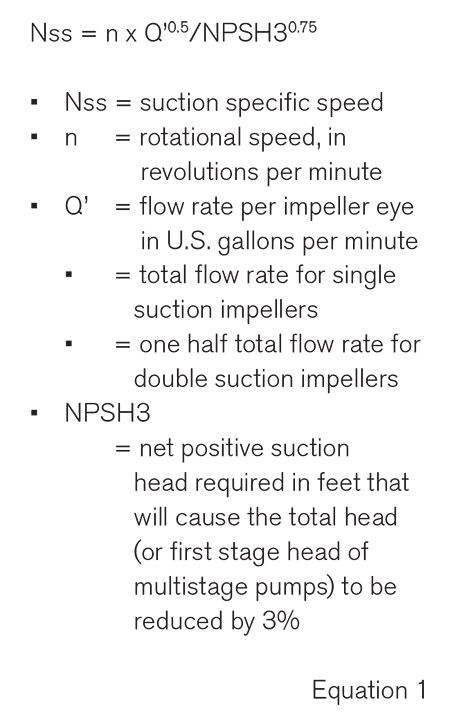

The maximum operating speed for a pump may be limited by the net positive suction head available (NPSHa) in the system and the suction characteristics of the first stage. As the speed of a pump impeller increases, the size of the impeller and pump can be reduced for the duty point, but the NPSH required (NPSHr) will increase. Therefore, if a higher speed pump is desired, then more attention will need to be paid to the pump’s suction performance.
Suction specific speed (Nss) is an index of pump suction operating characteristics. It is determined at the best efficiency point (BEP) flow rate with the maximum diameter impeller. Nss is an indicator of the NPSHr for a 3% drop in head (NPSH3) at a given rate of flow and rotational speed (see Nss in United States customary units in Equation 1).
If it is desired to stay below a certain Nss, the equation for Nss can be rearranged with the system NPSHa substituted for NPSH3 and solved for rotational speed (n), as in Equation 2.
For example, water and wastewater pumps are frequently supplied with soft bronze or cast iron impellers, neither of which provides significant cavitation resistance (see ANSI/HI 9.1-9.5 Pumps General Guidelines regarding cavitation resistant materials).
Additionally, municipal water and wastewater pumps are frequently operated at flow rates above or below the preferred operating region (POR), to match demand. The materials, operation outside the POR and higher Nss designs result in a higher recommended NPSH margin. Therefore, in these instances, a lower Nss may be desired and used to calculate a rotational speed that will result in reliable operation. For more on pump speed and NPSH, refer to ANSI/HI Standard 9.6.1 – Rotodynamic Pumps Guideline for NPSH Margin at www.pumps.org/standards.


